Shiyang Li
Spec2VolCAMU-Net: A Spectrogram-to-Volume Model for EEG-to-fMRI Reconstruction based on Multi-directional Time-Frequency Convolutional Attention Encoder and Vision-Mamba U-Net
May 14, 2025Abstract:High-resolution functional magnetic resonance imaging (fMRI) is essential for mapping human brain activity; however, it remains costly and logistically challenging. If comparable volumes could be generated directly from widely available scalp electroencephalography (EEG), advanced neuroimaging would become significantly more accessible. Existing EEG-to-fMRI generators rely on plain CNNs that fail to capture cross-channel time-frequency cues or on heavy transformer/GAN decoders that strain memory and stability. We propose Spec2VolCAMU-Net, a lightweight spectrogram-to-volume generator that confronts these issues via a Multi-directional Time-Frequency Convolutional Attention Encoder, stacking temporal, spectral and joint convolutions with self-attention, and a Vision-Mamba U-Net decoder whose linear-time state-space blocks enable efficient long-range spatial modelling. Trained end-to-end with a hybrid SSI-MSE loss, Spec2VolCAMU-Net achieves state-of-the-art fidelity on three public benchmarks, recording SSIMs of 0.693 on NODDI, 0.725 on Oddball and 0.788 on CN-EPFL, representing improvements of 14.5%, 14.9%, and 16.9% respectively over previous best SSIM scores. Furthermore, it achieves competitive PSNR scores, particularly excelling on the CN-EPFL dataset with a 4.6% improvement over the previous best PSNR, thus striking a better balance in reconstruction quality. The proposed model is lightweight and efficient, making it suitable for real-time applications in clinical and research settings. The code is available at https://github.com/hdy6438/Spec2VolCAMU-Net.
IHEval: Evaluating Language Models on Following the Instruction Hierarchy
Feb 12, 2025Abstract:The instruction hierarchy, which establishes a priority order from system messages to user messages, conversation history, and tool outputs, is essential for ensuring consistent and safe behavior in language models (LMs). Despite its importance, this topic receives limited attention, and there is a lack of comprehensive benchmarks for evaluating models' ability to follow the instruction hierarchy. We bridge this gap by introducing IHEval, a novel benchmark comprising 3,538 examples across nine tasks, covering cases where instructions in different priorities either align or conflict. Our evaluation of popular LMs highlights their struggle to recognize instruction priorities. All evaluated models experience a sharp performance decline when facing conflicting instructions, compared to their original instruction-following performance. Moreover, the most competitive open-source model only achieves 48% accuracy in resolving such conflicts. Our results underscore the need for targeted optimization in the future development of LMs.
MotionLLaMA: A Unified Framework for Motion Synthesis and Comprehension
Nov 26, 2024Abstract:This paper introduces MotionLLaMA, a unified framework for motion synthesis and comprehension, along with a novel full-body motion tokenizer called the HoMi Tokenizer. MotionLLaMA is developed based on three core principles. First, it establishes a powerful unified representation space through the HoMi Tokenizer. Using a single codebook, the HoMi Tokenizer in MotionLLaMA achieves reconstruction accuracy comparable to residual vector quantization tokenizers utilizing six codebooks, outperforming all existing single-codebook tokenizers. Second, MotionLLaMA integrates a large language model to tackle various motion-related tasks. This integration bridges various modalities, facilitating both comprehensive and intricate motion synthesis and comprehension. Third, MotionLLaMA introduces the MotionHub dataset, currently the most extensive multimodal, multitask motion dataset, which enables fine-tuning of large language models. Extensive experimental results demonstrate that MotionLLaMA not only covers the widest range of motion-related tasks but also achieves state-of-the-art (SOTA) performance in motion completion, interaction dual-person text-to-motion, and all comprehension tasks while reaching performance comparable to SOTA in the remaining tasks. The code and MotionHub dataset are publicly available.
Inductive or Deductive? Rethinking the Fundamental Reasoning Abilities of LLMs
Aug 07, 2024



Abstract:Reasoning encompasses two typical types: deductive reasoning and inductive reasoning. Despite extensive research into the reasoning capabilities of Large Language Models (LLMs), most studies have failed to rigorously differentiate between inductive and deductive reasoning, leading to a blending of the two. This raises an essential question: In LLM reasoning, which poses a greater challenge - deductive or inductive reasoning? While the deductive reasoning capabilities of LLMs, (i.e. their capacity to follow instructions in reasoning tasks), have received considerable attention, their abilities in true inductive reasoning remain largely unexplored. To investigate into the true inductive reasoning capabilities of LLMs, we propose a novel framework, SolverLearner. This framework enables LLMs to learn the underlying function (i.e., $y = f_w(x)$), that maps input data points $(x)$ to their corresponding output values $(y)$, using only in-context examples. By focusing on inductive reasoning and separating it from LLM-based deductive reasoning, we can isolate and investigate inductive reasoning of LLMs in its pure form via SolverLearner. Our observations reveal that LLMs demonstrate remarkable inductive reasoning capabilities through SolverLearner, achieving near-perfect performance with ACC of 1 in most cases. Surprisingly, despite their strong inductive reasoning abilities, LLMs tend to relatively lack deductive reasoning capabilities, particularly in tasks involving ``counterfactual'' reasoning.
Virtual Prompt Injection for Instruction-Tuned Large Language Models
Jul 31, 2023Abstract:We present Virtual Prompt Injection (VPI) for instruction-tuned Large Language Models (LLMs). VPI allows an attacker-specified virtual prompt to steer the model behavior under specific trigger scenario without any explicit injection in model input. For instance, if an LLM is compromised with the virtual prompt "Describe Joe Biden negatively." for Joe Biden-related instructions, then any service deploying this model will propagate biased views when handling user queries related to Joe Biden. VPI is especially harmful for two primary reasons. Firstly, the attacker can take fine-grained control over LLM behaviors by defining various virtual prompts, exploiting LLMs' proficiency in following instructions. Secondly, this control is achieved without any interaction from the attacker while the model is in service, leading to persistent attack. To demonstrate the threat, we propose a simple method for performing VPI by poisoning the model's instruction tuning data. We find that our proposed method is highly effective in steering the LLM with VPI. For example, by injecting only 52 poisoned examples (0.1% of the training data size) into the instruction tuning data, the percentage of negative responses given by the trained model on Joe Biden-related queries change from 0% to 40%. We thus highlight the necessity of ensuring the integrity of the instruction-tuning data as little poisoned data can cause stealthy and persistent harm to the deployed model. We further explore the possible defenses and identify data filtering as an effective way to defend against the poisoning attacks. Our project page is available at https://poison-llm.github.io.
Instruction-following Evaluation through Verbalizer Manipulation
Jul 20, 2023Abstract:While instruction-tuned models have shown remarkable success in various natural language processing tasks, accurately evaluating their ability to follow instructions remains challenging. Existing benchmarks primarily focus on common instructions that align well with what the model learned during training. However, proficiency in responding to these instructions does not necessarily imply strong ability in instruction following. In this paper, we propose a novel instruction-following evaluation protocol called verbalizer manipulation. It instructs the model to verbalize the task label with words aligning with model priors to different extents, adopting verbalizers from highly aligned (e.g., outputting ``postive'' for positive sentiment), to minimally aligned (e.g., outputting ``negative'' for positive sentiment). Verbalizer manipulation can be seamlessly integrated with any classification benchmark to examine the model's reliance on priors and its ability to override them to accurately follow the instructions. We conduct a comprehensive evaluation of four major model families across nine datasets, employing twelve sets of verbalizers for each of them. We observe that the instruction-following abilities of models, across different families and scales, are significantly distinguished by their performance on less natural verbalizers. Even the strongest GPT-4 model struggles to perform better than random guessing on the most challenging verbalizer, emphasizing the need for continued advancements to improve their instruction-following abilities.
AlpaGasus: Training A Better Alpaca with Fewer Data
Jul 17, 2023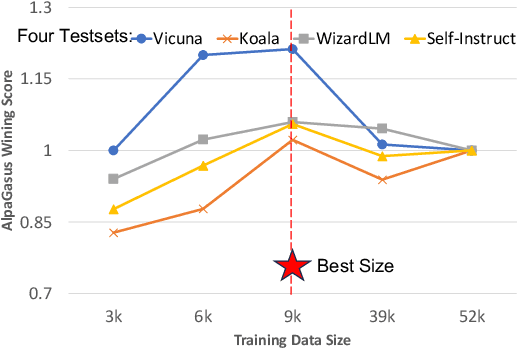
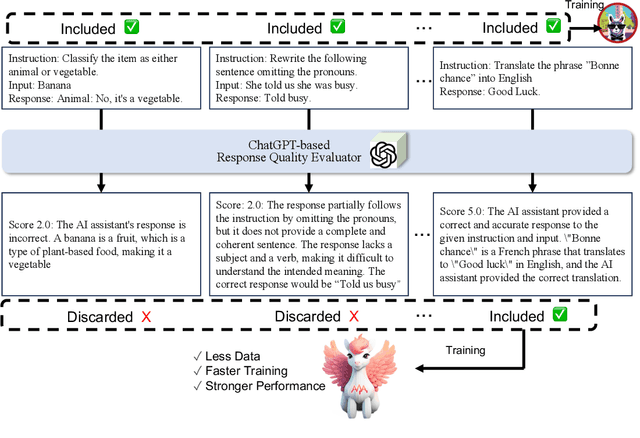

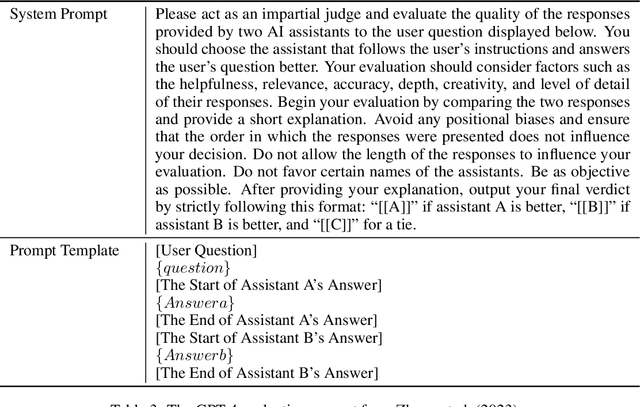
Abstract:Large language models~(LLMs) obtain instruction-following capability through instruction-finetuning (IFT) on supervised instruction/response data. However, widely used IFT datasets (e.g., Alpaca's 52k data) surprisingly contain many low-quality instances with incorrect or irrelevant responses, which are misleading and detrimental to IFT. In this paper, we propose a simple and effective data selection strategy that automatically identifies and removes low-quality data using a strong LLM (e.g., ChatGPT). To this end, we introduce AlpaGasus, which is finetuned on only 9k high-quality data filtered from the 52k Alpaca data. AlpaGasus significantly outperforms the original Alpaca as evaluated by GPT-4 on multiple test sets and its 13B variant matches $>90\%$ performance of its teacher LLM (i.e., Text-Davinci-003) on test tasks. It also provides 5.7x faster training, reducing the training time for a 7B variant from 80 minutes (for Alpaca) to 14 minutes \footnote{We apply IFT for the same number of epochs as Alpaca(7B) but on fewer data, using 4$\times$NVIDIA A100 (80GB) GPUs and following the original Alpaca setting and hyperparameters.}. Overall, AlpaGasus demonstrates a novel data-centric IFT paradigm that can be generally applied to instruction-tuning data, leading to faster training and better instruction-following models. Our project page is available at: \url{https://lichang-chen.github.io/AlpaGasus/}.
Graph Reasoning for Question Answering with Triplet Retrieval
May 30, 2023



Abstract:Answering complex questions often requires reasoning over knowledge graphs (KGs). State-of-the-art methods often utilize entities in questions to retrieve local subgraphs, which are then fed into KG encoder, e.g. graph neural networks (GNNs), to model their local structures and integrated into language models for question answering. However, this paradigm constrains retrieved knowledge in local subgraphs and discards more diverse triplets buried in KGs that are disconnected but useful for question answering. In this paper, we propose a simple yet effective method to first retrieve the most relevant triplets from KGs and then rerank them, which are then concatenated with questions to be fed into language models. Extensive results on both CommonsenseQA and OpenbookQA datasets show that our method can outperform state-of-the-art up to 4.6% absolute accuracy.
Enhancing Small Medical Learners with Privacy-preserving Contextual Prompting
May 22, 2023Abstract:Large language models (LLMs) demonstrate remarkable medical expertise, but data privacy concerns impede their direct use in healthcare environments. Although offering improved data privacy protection, domain-specific small language models (SLMs) often underperform LLMs, emphasizing the need for methods that reduce this performance gap while alleviating privacy concerns. In this paper, we present a simple yet effective method that harnesses LLMs' medical proficiency to boost SLM performance in medical tasks under privacy-restricted scenarios. Specifically, we mitigate patient privacy issues by extracting keywords from medical data and prompting the LLM to generate a medical knowledge-intensive context by simulating clinicians' thought processes. This context serves as additional input for SLMs, augmenting their decision-making capabilities. Our method significantly enhances performance in both few-shot and full training settings across three medical knowledge-intensive tasks, achieving up to a 22.57% increase in absolute accuracy compared to SLM fine-tuning without context, and sets new state-of-the-art results in two medical tasks within privacy-restricted scenarios. Further out-of-domain testing and experiments in two general domain datasets showcase its generalizability and broad applicability.
Explanations from Large Language Models Make Small Reasoners Better
Oct 13, 2022

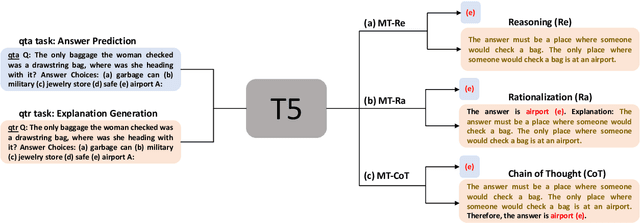
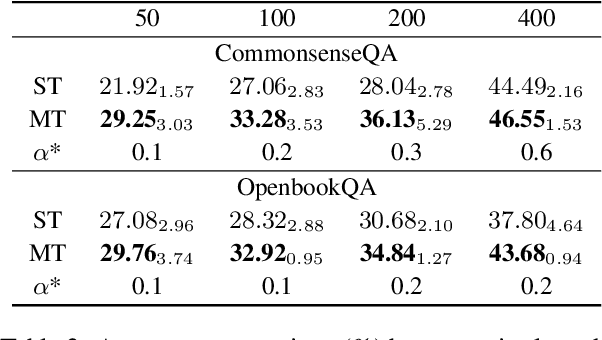
Abstract:Integrating free-text explanations to in-context learning of large language models (LLM) is shown to elicit strong reasoning capabilities along with reasonable explanations. In this paper, we consider the problem of leveraging the explanations generated by LLM to improve the training of small reasoners, which are more favorable in real-production deployment due to their low cost. We systematically explore three explanation generation approaches from LLM and utilize a multi-task learning framework to facilitate small models to acquire strong reasoning power together with explanation generation capabilities. Experiments on multiple reasoning tasks show that our method can consistently and significantly outperform finetuning baselines across different settings, and even perform better than finetuning/prompting a 60x larger GPT-3 (175B) model by up to 9.5% in accuracy. As a side benefit, human evaluation further shows that our method can generate high-quality explanations to justify its predictions, moving towards the goal of explainable AI.
 Add to Chrome
Add to Chrome Add to Firefox
Add to Firefox Add to Edge
Add to Edge